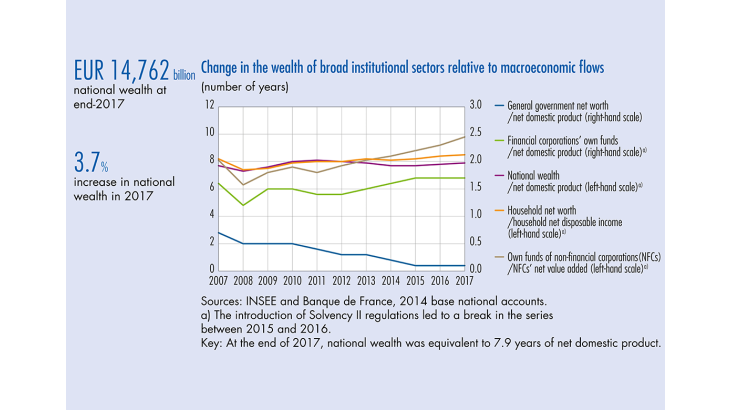At the end of 2017, France’s national wealth (or net worth; see definitions in Box 3) amounted to EUR 14,762 billion, equivalent to 7.9 times its net domestic product for the year (see Chart 1 and Box 1). The figure was up 3.7% on the year, continuing the robust growth seen in 2016 (2.7%; see Table 1). As in 2016, the rise stemmed from stronger growth in non-financial wealth (3.9% after 3.1% in 2016), especially in the value of land underlying buildings, dwellings, and other buildings and structures. Financial assets and liabilities (see definitions in Box 3) both rose by 6.5% after respective growth of 4.5% and 4.8% in 2016. In total, France’s financial net worth amounted to EUR 23 billion at end-2017, down from EUR 48 billion a year earlier.
1. Household wealth continued to be buoyed by accelerating real estate prices
At the end of 2017, household net worth (see definitions in Box 3) totalled EUR 11,494 billion, equivalent to nearly 8.5 times their net disposable income (see Chart 1). The figure was up 3.8% year-on-year, after a 3.0% growth rate in 2016. Around two thirds of household net worth is made up of non-financial assets, the majority of which take the form of real estate holdings (see definitions in Box 3). In 2017, the value of these real estate holdings rose by 3.3% (compared with 2.9% growth in 2016). The acceleration was driven by stronger gains in the price of second-hand dwellings (3.3%) and by high volumes of new construction. Overall, household non-financial wealth expanded by 3.5% in 2017 to a total of EUR 7,679 billion. The increase was stronger than the 3.0% rise seen in 2016, and higher than the average rate of growth over the previous decade (2.4% per year between 2005 and 2015; see Table 2).
With regard to financial assets, households continue to favour bank savings products. Currency and deposit holdings thus rose by 4.6% in 2017 (after 4.1% growth in 2016), reflecting a preference for passbook savings over more high-risk investments, and continuing strong inflows into overnight deposits. In the low interest rate environment, household debt security holdings dropped fairly markedly (decline of 12.5% after a 3.8% fall in 2016). Meanwhile, holdings of equity and investment fund shares grew by 8.1% after 4.9% growth in 2016, reflecting a stronger price effect in 2017 – the SBF 120 index gained 10.8% over 2017 compared with 4.7% the previous year.
[To read more, please download the article]
